Trends in the Social Security and Supplemental Security Income Disability Programs
Projected Future Course for SSA Disability Programs
Introduction
This section charts the projected future course of the Social Security Administration's disability programs. Projections for the Disability Insurance program show increasing costs and declining trust fund income, leading toward insolvency of the DI trust fund. By contrast, projections for the Supplemental Security Income disability program show that it appears to be on track to stabilize in size relative to the population and to actually decrease in cost as a portion of gross domestic product.
The data for all charts in this section come from SSA's Office of the Chief Actuary and are based on the intermediate assumptions of the Board of Trustees.1 The data on the DI program come from, or were used in the preparation of, the 2005 Annual Report of the Board of Trustees of the Federal Old-Age and Survivors Insurance and Disability Insurance Trust Funds. The Board of Trustees reports each year on the current and projected financial condition of the Social Security Administration's two separate trust funds: the Old-Age and Survivors Insurance Trust Fund and the Disability Insurance Trust Fund. The projections for future years reflect the Trustees' considered judgment about the demographic, economic, and program factors that affect income and expenditures. The Board of Trustees has historically produced estimates focused on 10-year (the short range) and 75-year (the long range) time frames, although in recent years estimates have been provided for the infinite time horizon. Projections are based on current Social Security law and do not anticipate any future changes that Congress might make.
Data on the SSI program come from, or were used in the preparation of, the 2004 Annual Report of the Supplemental Security Income Program. The Personal Responsibility and Work Opportunity Reconciliation Act of 1996 (Public Law 104-193) requires the Commissioner of Social Security to report annually to the President and Congress on the status of the Supplemental Security Income program. These reports are required to provide projections of program participation and costs at least 25 years into the future.
Growth in DI Beneficiaries per Covered Worker
The root cause of future insolvency in the DI program, as in the retirement program, is the increasing number of beneficiaries relative to the number of workers paying into the system. The number of DI beneficiaries per 100 covered workers is projected to grow by more than 40 percent between 2004 and 2030, from 4.8 to 6.8 per 100.
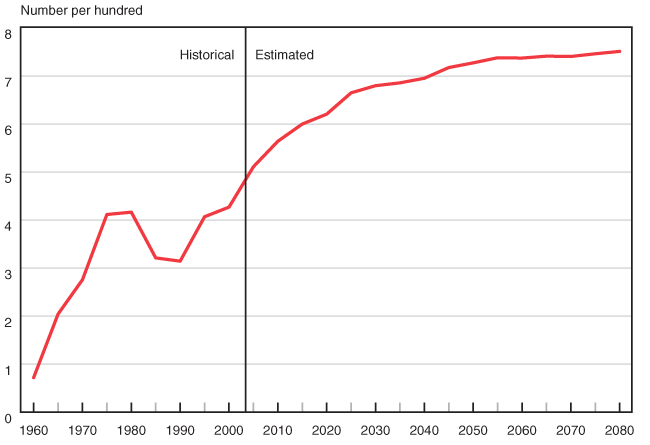
| Year | Beneficiaries |
|---|---|
| 1960 | 0.72 |
| 1965 | 2.04 |
| 1970 | 2.76 |
| 1975 | 4.12 |
| 1980 | 4.17 |
| 1985 | 3.21 |
| 1990 | 3.15 |
| 1995 | 4.07 |
| 2000 | 4.27 |
| 2005 | 5.11 |
| 2010 | 5.64 |
| 2015 | 6.00 |
| 2020 | 6.21 |
| 2025 | 6.65 |
| 2030 | 6.80 |
| 2035 | 6.86 |
| 2040 | 6.95 |
| 2045 | 7.18 |
| 2050 | 7.27 |
| 2055 | 7.38 |
| 2060 | 7.37 |
| 2065 | 7.41 |
| 2070 | 7.41 |
| 2075 | 7.46 |
| 2080 | 7.51 |
The root causes of future insolvency in the DI program are similar to those facing the retirement program. For example, the number of DI beneficiaries supported by 100 covered workers is increasing rapidly. In 1970, there were fewer than 3 beneficiaries per 100 covered workers; in 2004 there were 4.8. By 2030 the dependency ratio is projected to be 6.8 beneficiaries per 100 workers who are paying into Social Security, more than a 40 percent increase from the 2004 level. The same is true in the retirement program, though at even higher rates of dependency.
According to the 2005 Trustees Report, much of the increase in the ratio is attributable to the demographics of an aging population, with baby boomers entering the prime disability age group. Although age-adjusted incidence rates have increased in recent years, the Trustees Report projects that these rates will return to lower levels in the future.
Income and Costs of the DI Trust Fund
Income to the DI trust fund is projected to plateau as a percentage of gross domestic product while costs are projected to continue to grow, contributing to the solvency problem for the DI program.
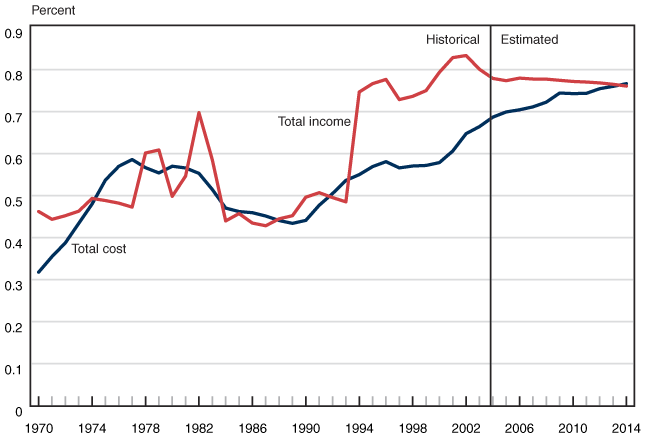
| Year | Total income | Total cost |
|---|---|---|
| 1970 | 0.46 | 0.32 |
| 1971 | 0.44 | 0.35 |
| 1972 | 0.45 | 0.39 |
| 1973 | 0.46 | 0.43 |
| 1974 | 0.49 | 0.48 |
| 1975 | 0.49 | 0.54 |
| 1976 | 0.48 | 0.57 |
| 1977 | 0.47 | 0.59 |
| 1978 | 0.60 | 0.57 |
| 1979 | 0.61 | 0.55 |
| 1980 | 0.50 | 0.57 |
| 1981 | 0.55 | 0.57 |
| 1982 | 0.70 | 0.55 |
| 1983 | 0.59 | 0.51 |
| 1984 | 0.44 | 0.47 |
| 1985 | 0.46 | 0.46 |
| 1986 | 0.43 | 0.46 |
| 1987 | 0.43 | 0.45 |
| 1988 | 0.44 | 0.44 |
| 1989 | 0.45 | 0.43 |
| 1990 | 0.50 | 0.44 |
| 1991 | 0.51 | 0.48 |
| 1992 | 0.50 | 0.50 |
| 1993 | 0.49 | 0.54 |
| 1994 | 0.75 | 0.55 |
| 1995 | 0.77 | 0.57 |
| 1996 | 0.78 | 0.58 |
| 1997 | 0.73 | 0.57 |
| 1998 | 0.74 | 0.57 |
| 1999 | 0.75 | 0.57 |
| 2000 | 0.79 | 0.58 |
| 2001 | 0.83 | 0.61 |
| 2002 | 0.83 | 0.65 |
| 2003 | 0.80 | 0.66 |
| 2004 | 0.78 | 0.69 |
| 2005 | 0.77 | 0.70 |
| 2006 | 0.78 | 0.70 |
| 2007 | 0.78 | 0.71 |
| 2008 | 0.78 | 0.72 |
| 2009 | 0.77 | 0.74 |
| 2010 | 0.77 | 0.74 |
| 2011 | 0.77 | 0.74 |
| 2012 | 0.77 | 0.75 |
| 2013 | 0.76 | 0.76 |
| 2014 | 0.76 | 0.77 |
Overall, the disability programs have generally been increasing as a proportion of gross domestic product (GDP) over the past few decades. As shown in Chart 17, the cost of Social Security's disability programs (including Medicaid and Medicare) increased from 0.32 percent of GDP in 1970 to 1.98 percent of GDP in 2001.
Chart 64 shows income and expenditures of the DI trust fund as a percentage of GDP from 1970 to 2014. Expenditures from the trust fund as a percentage of GDP rose from 0.3 percent in 1970 to nearly 0.6 percent in 1977 and then declined to 0.45 percent in 1989. Since then, expenditures have risen to a historical high of 0.69 percent of GDP in 2004 and are projected to continue to rise over the next decade. Income to the DI trust fund is projected to decline slightly, contributing to the solvency problem for DI.
Solvency of the DI Trust Fund
Social Security is facing issues of long-term solvency, with the DI trust fund facing exhaustion in 2027, 16 years before the insolvency of the Old-Age and Survivors Insurance (OASI) trust fund. The Hospital Insurance (HI) Trust Fund, which funds the Medicare program, will be exhausted even earlier, in 2020.
| Key dates | OASI | DI | OASDI | HI |
|---|---|---|---|---|
| First year that outgo exceeds income | ||||
| Excluding interest | 2018 | 2005 a | 2017 | 2004 |
| Including interest | 2028 | 2014 | 2027 | 2012 |
| Year that trust fund assets are exhausted | 2043 | 2027 | 2041 | 2020 |
| SOURCES: 2005 Annual Report of the Board of Trustees of the Federal Old-Age and Survivors Insurance and Disability Insurance Trust Funds and 2005 Annual Report of the Boards of Trustees of the Federal Hospital Insurance and Federal Supplementary Medical Insurance Trust Funds. | ||||
| a. In 2005, the DI trust fund met this threshold with total expenditures of $88.0 billion; income excluding interest was $87.1 billion. The DI trust fund, however, increased by $9.4 billion because of interest payments. | ||||
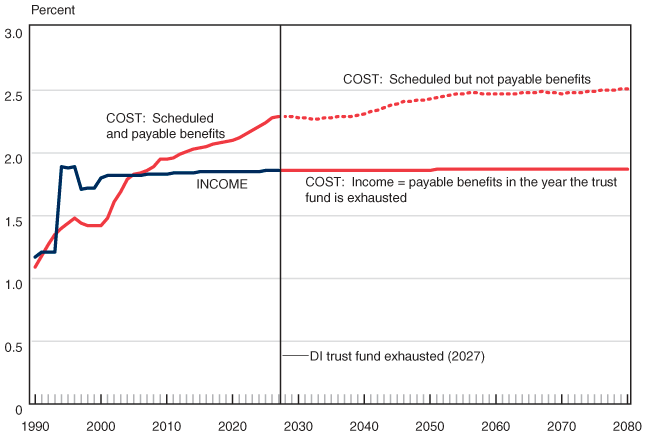
| Year | Income rate | Cost rate |
|---|---|---|
| 1990 | 1.17 | 1.09 |
| 1991 | 1.21 | 1.18 |
| 1992 | 1.21 | 1.27 |
| 1993 | 1.21 | 1.35 |
| 1994 | 1.89 | 1.40 |
| 1995 | 1.88 | 1.44 |
| 1996 | 1.89 | 1.48 |
| 1997 | 1.71 | 1.44 |
| 1998 | 1.72 | 1.42 |
| 1999 | 1.72 | 1.42 |
| 2000 | 1.80 | 1.42 |
| 2001 | 1.82 | 1.48 |
| 2002 | 1.82 | 1.61 |
| 2003 | 1.82 | 1.69 |
| 2004 | 1.82 | 1.79 |
| 2005 | 1.82 | 1.83 |
| 2006 | 1.82 | 1.84 |
| 2007 | 1.83 | 1.86 |
| 2008 | 1.83 | 1.89 |
| 2009 | 1.83 | 1.95 |
| 2010 | 1.83 | 1.95 |
| 2011 | 1.84 | 1.96 |
| 2012 | 1.84 | 1.99 |
| 2013 | 1.84 | 2.01 |
| 2014 | 1.84 | 2.03 |
| 2015 | 1.85 | 2.04 |
| 2016 | 1.85 | 2.05 |
| 2017 | 1.85 | 2.07 |
| 2018 | 1.85 | 2.08 |
| 2019 | 1.85 | 2.09 |
| 2020 | 1.85 | 2.10 |
| 2021 | 1.85 | 2.12 |
| 2022 | 1.85 | 2.15 |
| 2023 | 1.85 | 2.18 |
| 2024 | 1.85 | 2.21 |
| 2025 | 1.86 | 2.24 |
| 2026 | 1.86 | 2.28 |
| 2027 | 1.86 | 2.29 |
| 2028 | 1.86 | 2.29 |
| 2030 | 1.86 | 2.28 |
| 2031 | 1.86 | 2.28 |
| 2032 | 1.86 | 2.27 |
| 2033 | 1.86 | 2.27 |
| 2034 | 1.86 | 2.28 |
| 2035 | 1.86 | 2.28 |
| 2036 | 1.86 | 2.29 |
| 2037 | 1.86 | 2.29 |
| 2038 | 1.86 | 2.29 |
| 2039 | 1.86 | 2.30 |
| 2040 | 1.86 | 2.31 |
| 2041 | 1.86 | 2.33 |
| 2042 | 1.86 | 2.34 |
| 2043 | 1.86 | 2.36 |
| 2044 | 1.86 | 2.38 |
| 2045 | 1.86 | 2.39 |
| 2046 | 1.86 | 2.41 |
| 2047 | 1.86 | 2.41 |
| 2048 | 1.86 | 2.42 |
| 2049 | 1.86 | 2.42 |
| 2050 | 1.86 | 2.43 |
| 2051 | 1.87 | 2.44 |
| 2052 | 1.87 | 2.45 |
| 2053 | 1.87 | 2.46 |
| 2054 | 1.87 | 2.47 |
| 2055 | 1.87 | 2.47 |
| 2056 | 1.87 | 2.48 |
| 2057 | 1.87 | 2.48 |
| 2058 | 1.87 | 2.47 |
| 2059 | 1.87 | 2.47 |
| 2060 | 1.87 | 2.47 |
| 2061 | 1.87 | 2.47 |
| 2062 | 1.87 | 2.47 |
| 2063 | 1.87 | 2.47 |
| 2064 | 1.87 | 2.48 |
| 2065 | 1.87 | 2.48 |
| 2066 | 1.87 | 2.48 |
| 2067 | 1.87 | 2.49 |
| 2068 | 1.87 | 2.48 |
| 2069 | 1.87 | 2.48 |
| 2070 | 1.87 | 2.47 |
| 2071 | 1.87 | 2.48 |
| 2072 | 1.87 | 2.48 |
| 2073 | 1.87 | 2.48 |
| 2074 | 1.87 | 2.49 |
| 2075 | 1.87 | 2.49 |
| 2076 | 1.87 | 2.50 |
| 2077 | 1.87 | 2.50 |
| 2078 | 1.87 | 2.50 |
| 2079 | 1.87 | 2.51 |
| 2080 | 1.87 | 2.51 |
The increasing size and costs of the Social Security disability and Medicare programs are having adverse impacts on program solvency. The Trustees project that the DI trust fund will become insolvent in 2027, 16 years before the OASI trust fund. Furthermore, in 2005, total expenditures from the DI trust fund actually exceeded the inflow of tax receipts by $868 million, although the DI trust fund continued to increase because of interest payments. Note that this estimate does not include the costs of Medicare benefits provided to DI beneficiaries, which are also growing (Charts 6–9). The Hospital Insurance (HI) Trust Fund, which funds Medicare, is also facing a solvency problem, with that trust fund projected to be exhausted in 2020, 7 years earlier than the DI trust fund. Because all disabled widow(er)s and the majority of disabled adult children collect benefits from the OASI trust fund, disability policy has an effect, albeit very small, on the solvency of the retirement and survivors (OASI) trust fund as well.
Congress has numerous options to deal with the projected future insolvency of the DI trust fund, such as altering the benefit formula or eligibility rules, altering the share of payroll taxes devoted to the DI trust fund, raising overall payroll taxes, or undertaking more fundamental reform of the DI and OASI programs. However, in the absence of any Congressional action, the Trustees' intermediate projections suggest that in 2027 the DI trust fund will have insufficient resources to pay all scheduled benefits to DI beneficiaries.
This is not the first time the Disability Insurance Trust Fund has faced insolvency. As recently as the early 1990s, the DI trust fund was facing imminent insolvency and, in 1994, Congress enacted a change in the allocation of payroll taxes between the DI and OASI trust funds. The allocation of tax revenue to the DI trust fund was increased from 1.2 percent of taxable payroll to 1.8 percent. The 1995 Trustees Report estimated that, on the basis of the intermediate assumptions, the reallocation of taxes that occurred in 1994 would leave the DI trust fund solvent until 2016. Reallocations have also been made in the opposite direction, with Congress reallocating taxes away from the DI trust fund to the OASI trust fund. For example, the 1983 Amendments reduced the allocation to the DI trust fund and established a future schedule of tax allocations between the DI and OASI trust funds to help ensure solvency of the retirement program. As discussed earlier, benefit cuts and program tightening have also been used to control program costs, most notably in the late 1970s and early 1980s.
Growth in the SSI Population
Blind and disabled SSI recipients, as a percentage of the population in their age group, are projected to be relatively stable in the future, although anticipated growth in the population will lead to increases in the number of SSI recipients.
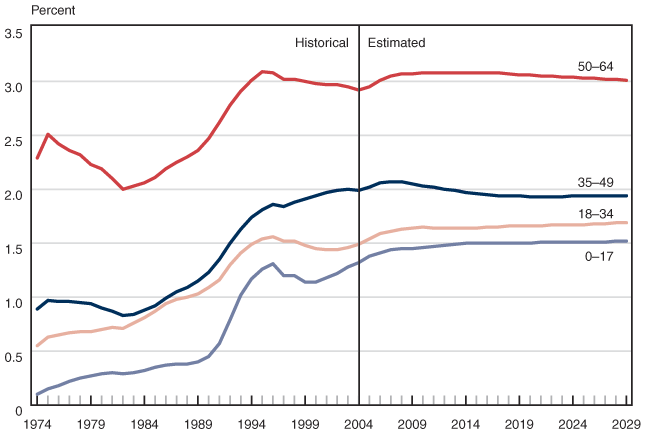
| Year | 0–17 | 18–34 | 35–49 | 50–64 |
|---|---|---|---|---|
| 1974 | 0.10 | 0.55 | 0.89 | 2.29 |
| 1975 | 0.15 | 0.63 | 0.97 | 2.51 |
| 1976 | 0.18 | 0.65 | 0.96 | 2.42 |
| 1977 | 0.22 | 0.67 | 0.96 | 2.36 |
| 1978 | 0.25 | 0.68 | 0.95 | 2.32 |
| 1979 | 0.27 | 0.68 | 0.94 | 2.23 |
| 1980 | 0.29 | 0.70 | 0.90 | 2.19 |
| 1981 | 0.30 | 0.72 | 0.87 | 2.10 |
| 1982 | 0.29 | 0.71 | 0.83 | 2.00 |
| 1983 | 0.30 | 0.76 | 0.84 | 2.03 |
| 1984 | 0.32 | 0.81 | 0.88 | 2.06 |
| 1985 | 0.35 | 0.87 | 0.92 | 2.11 |
| 1986 | 0.37 | 0.94 | 0.99 | 2.19 |
| 1987 | 0.38 | 0.98 | 1.05 | 2.25 |
| 1988 | 0.38 | 1.00 | 1.09 | 2.30 |
| 1989 | 0.40 | 1.03 | 1.15 | 2.36 |
| 1990 | 0.45 | 1.09 | 1.23 | 2.47 |
| 1991 | 0.57 | 1.16 | 1.35 | 2.62 |
| 1992 | 0.79 | 1.30 | 1.50 | 2.78 |
| 1993 | 1.02 | 1.41 | 1.63 | 2.91 |
| 1994 | 1.17 | 1.49 | 1.74 | 3.01 |
| 1995 | 1.26 | 1.54 | 1.81 | 3.09 |
| 1996 | 1.31 | 1.56 | 1.86 | 3.08 |
| 1997 | 1.20 | 1.52 | 1.84 | 3.02 |
| 1998 | 1.20 | 1.52 | 1.88 | 3.02 |
| 1999 | 1.14 | 1.48 | 1.91 | 3.00 |
| 2000 | 1.14 | 1.45 | 1.94 | 2.98 |
| 2001 | 1.18 | 1.44 | 1.97 | 2.97 |
| 2002 | 1.22 | 1.44 | 1.99 | 2.97 |
| 2003 | 1.28 | 1.46 | 2.00 | 2.95 |
| 2004 | 1.32 | 1.49 | 1.99 | 2.92 |
| 2005 | 1.38 | 1.54 | 2.02 | 2.95 |
| 2006 | 1.41 | 1.59 | 2.06 | 3.01 |
| 2007 | 1.44 | 1.61 | 2.07 | 3.05 |
| 2008 | 1.45 | 1.63 | 2.07 | 3.07 |
| 2009 | 1.45 | 1.64 | 2.05 | 3.07 |
| 2010 | 1.46 | 1.65 | 2.03 | 3.08 |
| 2011 | 1.47 | 1.64 | 2.02 | 3.08 |
| 2012 | 1.48 | 1.64 | 2.00 | 3.08 |
| 2013 | 1.49 | 1.64 | 1.99 | 3.08 |
| 2014 | 1.50 | 1.64 | 1.97 | 3.08 |
| 2015 | 1.50 | 1.64 | 1.96 | 3.08 |
| 2016 | 1.50 | 1.65 | 1.95 | 3.08 |
| 2017 | 1.50 | 1.65 | 1.94 | 3.08 |
| 2018 | 1.50 | 1.66 | 1.94 | 3.07 |
| 2019 | 1.50 | 1.66 | 1.94 | 3.06 |
| 2020 | 1.50 | 1.66 | 1.93 | 3.06 |
| 2021 | 1.51 | 1.66 | 1.93 | 3.05 |
| 2022 | 1.51 | 1.67 | 1.93 | 3.05 |
| 2023 | 1.51 | 1.67 | 1.93 | 3.04 |
| 2024 | 1.51 | 1.67 | 1.94 | 3.04 |
| 2025 | 1.51 | 1.67 | 1.94 | 3.03 |
| 2026 | 1.51 | 1.68 | 1.94 | 3.03 |
| 2027 | 1.51 | 1.68 | 1.94 | 3.02 |
| 2028 | 1.52 | 1.69 | 1.94 | 3.02 |
| 2029 | 1.52 | 1.69 | 1.94 | 3.01 |
The SSI program does not have a trust fund and is financed through general revenues. Thus, although there is no solvency issue for SSI, the potentially long-term deficit in general revenue receipts compared with expenditures makes it imperative to assess various budget priorities. The future of the SSI program looks to remain relatively stable, with the percentage of adults in the older age groups (35–64) projected to decrease slightly and the percentage in the younger age group (18–34) to increase modestly. The percentage of SSI disabled children (0–17) is also projected to increase slightly, with the projected increase moderating after 2014. Because the general population is expected to grow over this period, the number of SSI recipients is projected to continue increasing.
Costs of the SSI Program
The future of SSI for the blind and disabled is brighter than the future of the DI program, because the cost of the SSI program is projected to decline as a percentage of gross domestic product. However, the cost of the SSI program does not include costs related to Medicaid.
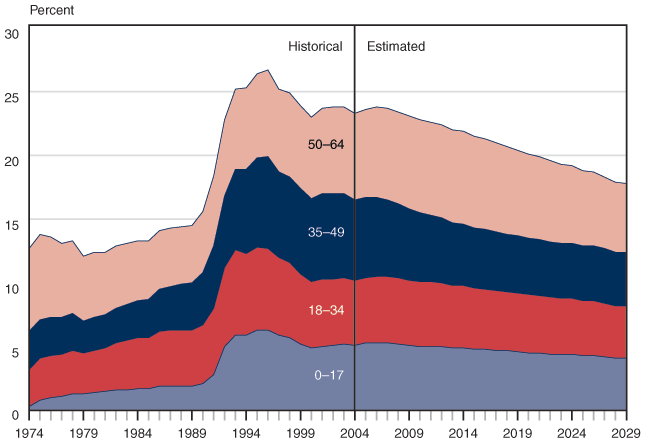
| Year | 0–17 | 18–34 | 35–49 | 50–64 |
|---|---|---|---|---|
| 1974 | 0.30 | 2.90 | 3.00 | 6.50 |
| 1975 | 0.80 | 3.30 | 3.00 | 6.70 |
| 1976 | 1.00 | 3.30 | 3.00 | 6.30 |
| 1977 | 1.10 | 3.30 | 2.90 | 5.80 |
| 1978 | 1.30 | 3.40 | 2.90 | 5.70 |
| 1979 | 1.30 | 3.20 | 2.50 | 5.10 |
| 1980 | 1.40 | 3.30 | 2.60 | 5.10 |
| 1981 | 1.50 | 3.40 | 2.60 | 4.90 |
| 1982 | 1.60 | 3.70 | 2.70 | 4.90 |
| 1983 | 1.60 | 3.90 | 2.80 | 4.80 |
| 1984 | 1.70 | 4.00 | 2.90 | 4.70 |
| 1985 | 1.70 | 4.00 | 3.00 | 4.60 |
| 1986 | 1.90 | 4.30 | 3.30 | 4.60 |
| 1987 | 1.90 | 4.40 | 3.40 | 4.60 |
| 1988 | 1.90 | 4.40 | 3.60 | 4.50 |
| 1989 | 1.90 | 4.40 | 3.70 | 4.50 |
| 1990 | 2.10 | 4.60 | 4.10 | 4.80 |
| 1991 | 2.80 | 5.20 | 4.90 | 5.50 |
| 1992 | 5.00 | 6.20 | 5.60 | 6.00 |
| 1993 | 5.90 | 6.70 | 6.30 | 6.30 |
| 1994 | 5.90 | 6.40 | 6.60 | 6.40 |
| 1995 | 6.30 | 6.50 | 7.00 | 6.60 |
| 1996 | 6.30 | 6.40 | 7.20 | 6.80 |
| 1997 | 5.90 | 6.10 | 6.70 | 6.50 |
| 1998 | 5.70 | 5.90 | 6.70 | 6.60 |
| 1999 | 5.20 | 5.50 | 6.70 | 6.50 |
| 2000 | 4.90 | 5.20 | 6.50 | 6.40 |
| 2001 | 5.00 | 5.30 | 6.70 | 6.70 |
| 2002 | 5.10 | 5.20 | 6.70 | 6.80 |
| 2003 | 5.20 | 5.20 | 6.60 | 6.80 |
| 2004 | 5.10 | 5.10 | 6.30 | 6.80 |
| 2005 | 5.30 | 5.10 | 6.30 | 6.90 |
| 2006 | 5.30 | 5.20 | 6.20 | 7.10 |
| 2007 | 5.30 | 5.20 | 6.00 | 7.20 |
| 2008 | 5.20 | 5.20 | 5.80 | 7.20 |
| 2009 | 5.10 | 5.10 | 5.60 | 7.30 |
| 2010 | 5.00 | 5.10 | 5.40 | 7.30 |
| 2011 | 5.00 | 5.10 | 5.20 | 7.30 |
| 2012 | 5.00 | 5.00 | 5.10 | 7.30 |
| 2013 | 4.90 | 4.90 | 4.90 | 7.30 |
| 2014 | 4.90 | 4.90 | 4.80 | 7.30 |
| 2015 | 4.80 | 4.80 | 4.70 | 7.20 |
| 2016 | 4.80 | 4.70 | 4.70 | 7.10 |
| 2017 | 4.70 | 4.70 | 4.60 | 7.00 |
| 2018 | 4.70 | 4.60 | 4.50 | 6.90 |
| 2019 | 4.60 | 4.60 | 4.50 | 6.70 |
| 2020 | 4.50 | 4.60 | 4.40 | 6.60 |
| 2021 | 4.50 | 4.50 | 4.40 | 6.50 |
| 2022 | 4.40 | 4.50 | 4.30 | 6.40 |
| 2023 | 4.40 | 4.40 | 4.30 | 6.20 |
| 2024 | 4.40 | 4.40 | 4.30 | 6.10 |
| 2025 | 4.30 | 4.30 | 4.30 | 5.90 |
| 2026 | 4.30 | 4.30 | 4.30 | 5.80 |
| 2027 | 4.20 | 4.20 | 4.30 | 5.60 |
| 2028 | 4.10 | 4.10 | 4.20 | 5.50 |
| 2029 | 4.10 | 4.10 | 4.20 | 5.40 |
The cost of federal SSI payments to the blind and disabled is shown as a percentage of gross domestic product (GDP). Although the cost of the program as a percentage of GDP was higher in 2004 than it was in 1974, the cost relative to GDP actually declined between 1996 and 2000, before increasing slightly in the past several years. Overall, however, the financial future of SSI is brighter than that of the DI program, because the cost of the SSI program is projected to decline as a percentage of GDP. As noted in Chart 66, age plays little role in determining the future composition of the SSI rolls, so costs relative to GDP decline for all age groups.
Number of SSI Recipients
The projected decline in costs relative to gross domestic product is not a function of decreasing numbers of SSI disabled recipients, since the number of recipients is projected to increase well into the future.
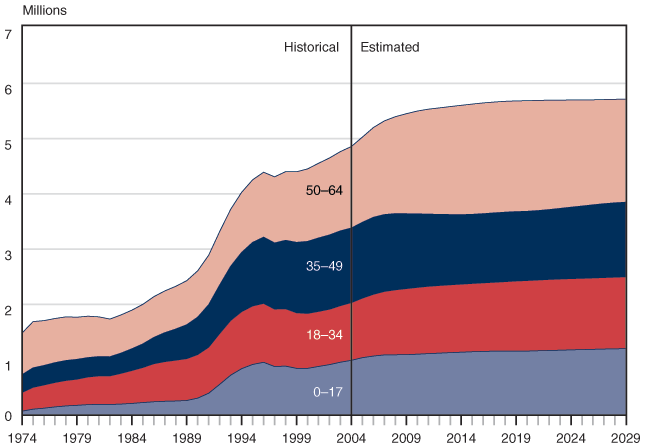
| Year | 0–17 | 18–34 | 35–49 | 50–64 |
|---|---|---|---|---|
| 1974 | 0.07 | 0.34 | 0.32 | 0.76 |
| 1975 | 0.11 | 0.40 | 0.35 | 0.84 |
| 1976 | 0.12 | 0.42 | 0.35 | 0.81 |
| 1977 | 0.15 | 0.44 | 0.36 | 0.80 |
| 1978 | 0.17 | 0.46 | 0.36 | 0.79 |
| 1979 | 0.18 | 0.47 | 0.36 | 0.76 |
| 1980 | 0.19 | 0.50 | 0.35 | 0.75 |
| 1981 | 0.19 | 0.51 | 0.35 | 0.72 |
| 1982 | 0.19 | 0.52 | 0.35 | 0.68 |
| 1983 | 0.20 | 0.56 | 0.37 | 0.69 |
| 1984 | 0.21 | 0.60 | 0.39 | 0.70 |
| 1985 | 0.23 | 0.63 | 0.43 | 0.72 |
| 1986 | 0.24 | 0.69 | 0.48 | 0.74 |
| 1987 | 0.25 | 0.72 | 0.52 | 0.76 |
| 1988 | 0.25 | 0.74 | 0.56 | 0.77 |
| 1989 | 0.26 | 0.76 | 0.61 | 0.80 |
| 1990 | 0.31 | 0.79 | 0.68 | 0.84 |
| 1991 | 0.40 | 0.83 | 0.77 | 0.90 |
| 1992 | 0.56 | 0.92 | 0.88 | 0.97 |
| 1993 | 0.72 | 0.99 | 0.98 | 1.03 |
| 1994 | 0.84 | 1.03 | 1.07 | 1.09 |
| 1995 | 0.92 | 1.06 | 1.15 | 1.13 |
| 1996 | 0.95 | 1.07 | 1.20 | 1.18 |
| 1997 | 0.88 | 1.04 | 1.20 | 1.20 |
| 1998 | 0.89 | 1.04 | 1.24 | 1.24 |
| 1999 | 0.85 | 1.01 | 1.27 | 1.28 |
| 2000 | 0.84 | 0.99 | 1.30 | 1.31 |
| 2001 | 0.88 | 1.00 | 1.33 | 1.35 |
| 2002 | 0.91 | 1.00 | 1.34 | 1.39 |
| 2003 | 0.96 | 1.02 | 1.35 | 1.44 |
| 2004 | 0.99 | 1.04 | 1.35 | 1.48 |
| 2005 | 1.04 | 1.08 | 1.37 | 1.54 |
| 2006 | 1.07 | 1.12 | 1.39 | 1.63 |
| 2007 | 1.09 | 1.15 | 1.39 | 1.70 |
| 2008 | 1.09 | 1.18 | 1.38 | 1.76 |
| 2009 | 1.09 | 1.19 | 1.36 | 1.81 |
| 2010 | 1.10 | 1.21 | 1.33 | 1.86 |
| 2011 | 1.11 | 1.22 | 1.31 | 1.90 |
| 2012 | 1.12 | 1.22 | 1.29 | 1.93 |
| 2013 | 1.13 | 1.23 | 1.27 | 1.95 |
| 2014 | 1.14 | 1.23 | 1.26 | 1.98 |
| 2015 | 1.15 | 1.24 | 1.25 | 2.00 |
| 2016 | 1.15 | 1.24 | 1.25 | 2.01 |
| 2017 | 1.16 | 1.25 | 1.26 | 2.01 |
| 2018 | 1.16 | 1.26 | 1.26 | 2.01 |
| 2019 | 1.16 | 1.27 | 1.26 | 2.01 |
| 2020 | 1.16 | 1.28 | 1.25 | 2.00 |
| 2021 | 1.16 | 1.28 | 1.26 | 2.00 |
| 2022 | 1.17 | 1.29 | 1.26 | 1.98 |
| 2023 | 1.17 | 1.29 | 1.28 | 1.96 |
| 2024 | 1.18 | 1.29 | 1.29 | 1.94 |
| 2025 | 1.18 | 1.29 | 1.31 | 1.92 |
| 2026 | 1.19 | 1.29 | 1.32 | 1.90 |
| 2027 | 1.19 | 1.29 | 1.34 | 1.89 |
| 2028 | 1.20 | 1.30 | 1.35 | 1.87 |
| 2029 | 1.20 | 1.30 | 1.35 | 1.87 |
The projected decline in costs relative to gross domestic product is not a function of decreasing numbers of SSI disabled recipients, since the number of recipients is projected to increase, albeit slowly, well into the future. The increase in the number of recipients appears to be related to the size of the population, rather than to an increase in the prevalence of disability, since the SSI population is projected to be relatively stable or even decline as a portion of the population in each age group (Chart 66). This relationship indicates that the projected growth in the economy will play a role in diminishing the cost of the program relative to GDP. This analysis does not include the cost of Medicaid for the disabled, which, as shown in Chart 17, has been growing much more quickly than has the cost of the disability programs administered by SSA.
Note
1. Because any projection of future experience is uncertain, the Trustees use three alternative sets of assumptions to show a range of possible outcomes: the intermediate set of assumptions (alternative II) reflects the Trustees' best estimate of the future financial outlook of the two trust funds; the low-cost alternative I is more optimistic, and the high-cost alternative III is more pessimistic.